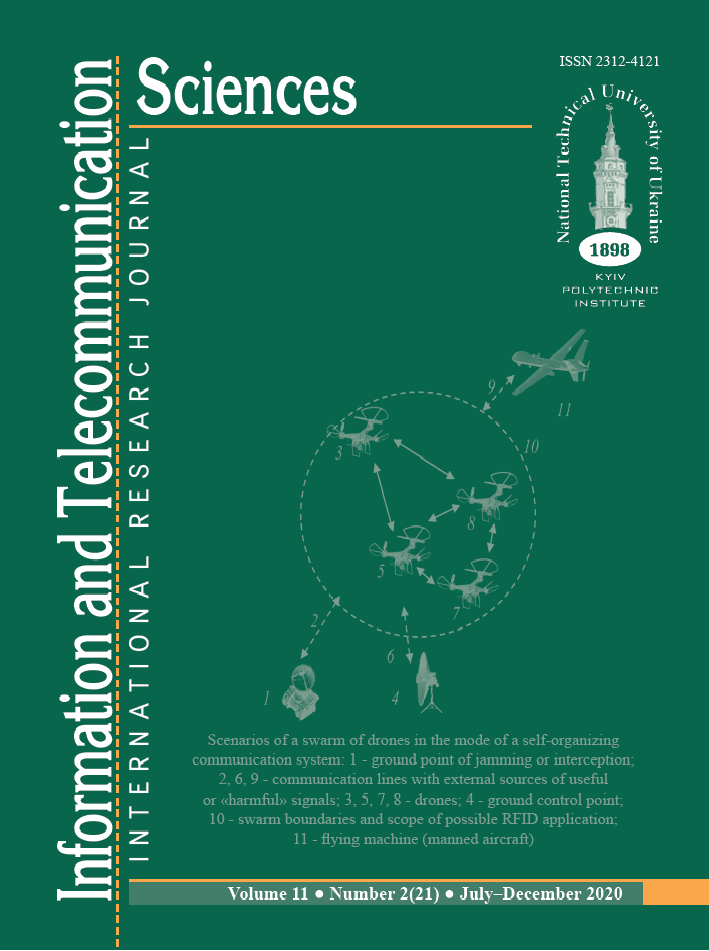NEW COMPOSITE BARKER CODES IN THE SYNCHRONIZATION SYSTEM OF BROADBAND SIGNALS
DOI:
https://doi.org/10.20535/2411-2976.22020.24-30Keywords:
Barker codes, composite Barker codes, autocorrelation function.Abstract
Background. At present, the demand for broadband signals (BВS) is determined by the qualities inherent in these signals, which make it possible to ensure high noise immunity of broadband communication systems (BСS) when transmitting confidential information in an open radio channel, especially in emergency situations. Although the foundations of the BВS theory are well known, the development of wireless communication networks requires constant refinements of theoretical provisions in accordance with new data on methods for constructing Barker code sequences used in wireless communication
systems with direct sequence spread spectrum technology.
Objective. The aim of the paper is to study new composite Barker codes as synchronization signals and compare them with known composite codes using simulation.
Methods. Analytical methods of calculation are used, as well as simulation modeling in the MatLab software package.
Results. Simulation modeling was carried out, which confirmed the possibility of using new composite Barker codes as synchronization signals in the BCS.
Conclusions. Modeling in the MatLab software package showed a greater noise immunity of new composite codes to the influence of various modulating sequences of an information signal in comparison with known composite codes.
References
Sklar B. Digital Communication. Theoretical basis and
practical application. - M.: Publishing house "Williams",
- 1104 p.
Shakhnovich I.V. Modern technologies of wireless
communication. M., Technosphere, 2006. 288 p. (in Russian)
Sergeev M.B., Nenashev V.A., Sergeev A.M. Nested
code sequences of Barker-Mersenne-Raghavarao.
Information and control systems, 2019, No. 3, pp. 71-81.
(in Russian)
Barker, R. H. "Group Synchronizing of Binary Digital
Sequences". Communication Theory. London: Butterworth. P. 273–287.
Banket V.L., Tokar’ M.S. "Composite Barker Codes" //
Digital Technologies No. 2, 2007. pp.8-17. (in Russian)
Volynskaya A.V. Results of mathematical modeling of
the code sequence searching process with given correlation
properties // USURT Herald: Scientific-technological journal. - Ekaterinburg: USURT, 2009. - No. 3-4. - pp. 64–71. (in Russian)
Maksimov V.V., Chuprina R.S. Inverse composite
Barker codes // Scientific notes UNIIS, №1 (21), 2012 - pp.
-76. (in Russian)
Volynskaya A.V., Kalinin P.M. New noise-immune
signals for an intelligent telemechanics channel //
Fundamental Research №11, 2012. - pp. 922-926. (in Russian)
Maksymov V., Khrapovitsky I. Research of composite
Barker codes // The scientific heritage, № 48 (2020), Р.1,pp. 15-22.
Baskakov S.I. Radiotechnical circuits and signals:
Textbook. - M. Higher. school, 1983. – 536 p. (in Russian)
Maksimov V.V., Khrapovitsky I.А. New composite
barker codes // The scientific heritage, № 49 (2020), Р.1,pp. 29-35.
Downloads
Published
How to Cite
Issue
Section
License
The ownership of copyright remains with the Authors.
Authors may use their own material in other publications provided that the Journal is acknowledged as the original place of publication and National Technical University of Ukraine “Igor Sikorsky Kyiv Polytechnic Institute” as the Publisher.
ITS articles are published under Creative Commons licence:
- Authors retain copyright and grant the journal right of first publication with the work simultaneously licensed under CC BY 4.0that allows others to share the work with an acknowledgement of the work's authorship and initial publication in this journal.
- Authors are able to enter into separate, additional contractual arrangements for the non-exclusive distribution of the journal's published version of the work (e.g., post it to an institutional repository or publish it in a book), with an acknowledgement of its initial publication in this journal.
- Authors are permitted and encouraged to post their work online (e.g., in institutional repositories or on their website) prior to and during the submission process, as it can lead to productive exchanges, as well as earlier and greater citation of published work.

